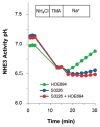Human enteroids as an ex-vivo model of host-pathogen interactions in the gastrointestinal tract
- PMID: 24719375
- PMCID: PMC4380516
- DOI: 10.1177/1535370214529398
Human enteroids as an ex-vivo model of host-pathogen interactions in the gastrointestinal tract
Abstract
Currently, 9 out of 10 experimental drugs fail in clinical studies. This has caused a 40% plunge in the number of drugs approved by the US Food and Drug Administration (FDA) since 2005. It has been suggested that the mechanistic differences between human diseases modeled in animals (mostly rodents) and the pathophysiology of human diseases might be one of the critical factors that contribute to drug failure in clinical trials. Rapid progress in the field of human stem cell technology has allowed the in-vitro recreation of human tissue that should complement and expand upon the limitations of cell and animal models currently used to study human diseases and drug toxicity. Recent success in the identification and isolation of human intestinal epithelial stem cells (Lgr5(+)) from the small intestine and colon has led to culture of functional intestinal epithelial units termed organoids or enteroids. Intestinal enteroids are comprised of all four types of normal epithelial cells and develop a crypt-villus differentiation axis. They demonstrate major intestinal physiologic functions, including Na(+) absorption and Cl(-) secretion. This review discusses the recent progress in establishing human enteroids as a model of infectious diarrheal diseases such as cholera, rotavirus, and enterohemorrhagic Escherichia coli, and use of the enteroids to determine ways to correct the diarrhea-induced ion transport abnormalities via drug therapy.
Keywords: Enteroids; host–pathogen interaction; intestinal pathophysiology; intestinal physiology.
© 2014 by the Society for Experimental Biology and Medicine.
Figures





Similar articles
-
Human Enteroids as a Model of Upper Small Intestinal Ion Transport Physiology and Pathophysiology.Gastroenterology. 2016 Mar;150(3):638-649.e8. doi: 10.1053/j.gastro.2015.11.047. Epub 2015 Dec 8. Gastroenterology. 2016. PMID: 26677983 Free PMC article.
-
Human mini-guts: new insights into intestinal physiology and host-pathogen interactions.Nat Rev Gastroenterol Hepatol. 2016 Nov;13(11):633-642. doi: 10.1038/nrgastro.2016.142. Epub 2016 Sep 28. Nat Rev Gastroenterol Hepatol. 2016. PMID: 27677718 Free PMC article. Review.
-
Establishment of human epithelial enteroids and colonoids from whole tissue and biopsy.J Vis Exp. 2015 Mar 6;(97):52483. doi: 10.3791/52483. J Vis Exp. 2015. PMID: 25866936 Free PMC article.
-
Human Intestinal Enteroids: a New Model To Study Human Rotavirus Infection, Host Restriction, and Pathophysiology.J Virol. 2015 Oct 7;90(1):43-56. doi: 10.1128/JVI.01930-15. Print 2016 Jan 1. J Virol. 2015. PMID: 26446608 Free PMC article.
-
The Contributions of Human Mini-Intestines to the Study of Intestinal Physiology and Pathophysiology.Annu Rev Physiol. 2017 Feb 10;79:291-312. doi: 10.1146/annurev-physiol-021115-105211. Annu Rev Physiol. 2017. PMID: 28192061 Free PMC article. Review.
Cited by
-
Differential Response to the Course of Cryptosporidium parvum Infection and Its Impact on Epithelial Integrity in Differentiated versus Undifferentiated Human Intestinal Enteroids.Infect Immun. 2022 Nov 17;90(11):e0039722. doi: 10.1128/iai.00397-22. Epub 2022 Oct 26. Infect Immun. 2022. PMID: 36286526 Free PMC article.
-
THE SMALL INTESTINAL MICROBIOME: VIBING WITH INTESTINAL STEM CELLS.Microbiota Host. 2023;1(1):e230012. doi: 10.1530/mah-23-0012. Epub 2023 Nov 1. Microbiota Host. 2023. PMID: 38957594 Free PMC article.
-
Organoids: a promising new in vitro platform in livestock and veterinary research.Vet Res. 2021 Mar 10;52(1):43. doi: 10.1186/s13567-021-00904-2. Vet Res. 2021. PMID: 33691792 Free PMC article. Review.
-
Generation of CRISPR-Cas9-mediated genetic knockout human intestinal tissue-derived enteroid lines by lentivirus transduction and single-cell cloning.Nat Protoc. 2022 Apr;17(4):1004-1027. doi: 10.1038/s41596-021-00669-0. Epub 2022 Feb 23. Nat Protoc. 2022. PMID: 35197604 Free PMC article. Review.
-
Profiling of rotavirus 3'UTR-binding proteins reveals the ATP synthase subunit ATP5B as a host factor that supports late-stage virus replication.J Biol Chem. 2019 Apr 12;294(15):5993-6006. doi: 10.1074/jbc.RA118.006004. Epub 2019 Feb 15. J Biol Chem. 2019. PMID: 30770472 Free PMC article.
References
-
- Sato T, Vries RG, Snippert HJ, van de Wetering M, Barker N, Stange DE, van Es JH, Abo A, Kujala P, Peters PJ, Clevers H. Single Lgr5 stem cells build crypt-villus structures in vitro without a mesenchymal niche. Nature. 2009;459:262–5. - PubMed
-
- Jung P, Sato T, Merlos-Suárez A, Barriga FM, Iglesias M, Rossell D, Auer H, Gallardo M, Blasco MA, Sancho E, Clevers H, Batlle E. Isolation and in vitro expansion of human colonic stem cells. Nat Med. 2011;17:1225–7. - PubMed
-
- Sato T, Stange DE, Ferrante M, Vries RGJ, van Es JH, van den Brink S, van Houdt WJ, Pronk A, van Gorp J, Siersema PD, Clevers H. Long-term expansion of epithelial organoids from human colon, adenoma, adeno-carcinoma, and Barrett’s epithelium. Gastroenterology. 2011;141:1762–72. - PubMed
-
- Woodcock J, Woosley R. The FDA critical path initiative and its influence on new drug development. Annu Rev Med. 2008;59:1–12. - PubMed
-
- Hidalgo IJ, Raub TJ, Borchardt RT. Characterization of the human colon carcinoma cell line (Caco-2) as a model system for intestinal epithelial permeability. Gastroenterology. 1989;96:736–49. - PubMed
Publication types
MeSH terms
Grants and funding
- R24 DK099803/DK/NIDDK NIH HHS/United States
- R01-DK061765/DK/NIDDK NIH HHS/United States
- U19 AI116497/AI/NIAID NIH HHS/United States
- R01 DK026523/DK/NIDDK NIH HHS/United States
- P30 DK056338/DK/NIDDK NIH HHS/United States
- T32 DK007632/DK/NIDDK NIH HHS/United States
- K08 DK088950/DK/NIDDK NIH HHS/United States
- P01 DK072084/DK/NIDDK NIH HHS/United States
- P01-DK072084/DK/NIDDK NIH HHS/United States
- K01-DK088950/DK/NIDDK NIH HHS/United States
- R01-DK026523/DK/NIDDK NIH HHS/United States
- R24 DK064388/DK/NIDDK NIH HHS/United States
- K01 DK093657/DK/NIDDK NIH HHS/United States
- P30 DK089502/DK/NIDDK NIH HHS/United States
- R01 DK061765/DK/NIDDK NIH HHS/United States
- R01-AI080656/AI/NIAID NIH HHS/United States
- P30-DK089502/DK/NIDDK NIH HHS/United States
- R01 AI080656/AI/NIAID NIH HHS/United States
- U18 TR000552/TR/NCATS NIH HHS/United States
- U18-TR000552/TR/NCATS NIH HHS/United States
- P30-DK056338/DK/NIDDK NIH HHS/United States
- T32-DK007632/DK/NIDDK NIH HHS/United States
LinkOut - more resources
Full Text Sources
Other Literature Sources
Medical

